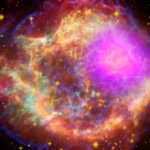Imagine the biggest firework you have ever seen, then multiply it by a billion. Now imagine a whole galaxy of fireworks going off at once. That is still not as bright or as powerful as a supernova, which is the explosion of a star. A supernova is the most dramatic and powerful event in space, marking the end of a star’s life in a final, brilliant blast.
This spectacular event is not just a show for us to watch. Supernovas are incredibly important. They are the cosmic engines that create many of the elements in the universe, including the ones that make up our planet and even our own bodies. Understanding what happens in a supernova is key to understanding where we come from and how the universe works. In this article, we will take a deep dive into the life and explosive death of a star to discover the powerful secrets of a supernova.
The Life of a Star (Before the Explosion)
To understand how a star dies in a supernova, we first need to understand how it lives. A star is a giant ball of very hot gas, mostly hydrogen. For most of its life, a star is in a careful balance. The star’s own gravity is always pulling everything inward, trying to crush it all into a small ball. At the same time, the star is creating a huge amount of energy from a process called nuclear fusion. This is when a star turns lighter elements, like hydrogen, into heavier ones, like helium. This fusion creates an outward push that holds the star up and keeps it from collapsing.
This balance between the inward pull of gravity and the outward push of fusion is what keeps a star stable and shining for millions or even billions of years. Our Sun, for example, is in this stable part of its life.
However, the stars that can create a supernova are much, much bigger than our Sun. They are at least eight times the size of our Sun. Because they are so big, they burn through their fuel much faster.
The Star Runs Out of Fuel
This balance can’t last forever. The star will eventually start to run out of its main fuel, hydrogen. When this happens, the star’s heart, or core, starts to get hotter and hotter. It begins to fuse heavier elements, like helium, into even heavier ones, like carbon and oxygen. This process continues, creating layers inside the star, like an onion. The star’s core has the heaviest elements, and the outer layers have the lightest elements.
The star keeps making heavier elements all the way up to iron. This is a very important moment in the star’s life. When a star creates iron in its core, it cannot make any more energy from fusion. Fusing iron actually uses up energy instead of making it. This is the beginning of the end.
With no more energy being created in the star’s heart, there is nothing left to push back against the crushing force of gravity.
The Final Collapse: A Cosmic Crash
Once the star’s core is full of iron, the battle between gravity and fusion is over. Gravity wins. In less than a second, the core of the star collapses in on itself with incredible speed. It crashes inward with a force so powerful that it’s almost impossible to imagine. The star’s core shrinks from being the size of our Earth to being only about 12 miles wide, all in a tiny fraction of a second.
This collapse is a crucial moment. The core becomes so incredibly dense that it can’t be squeezed any further. The inner part of the core acts like a solid wall. The rest of the star’s material, which is still falling inward, crashes into this super-dense core.
The Big Explosion: The Supernova
When the falling material hits the hard, dense core, it bounces back out. This creates a powerful shockwave that blasts outward through the rest of the star. This massive wave of energy rips the star apart, shooting all of its outer layers into space.
This is the supernova explosion. It is so bright and powerful that for a short time, it can shine as brightly as an entire galaxy of billions of stars. It releases an immense amount of energy and sends all the elements that the star made during its life flying out into space.
What Happens After the Supernova?
The story doesn’t end with the explosion. The core of the star, the part that crashed in and bounced back, is left behind. Its fate depends on how heavy it was.
The Birth of a Neutron Star
If the star’s leftover core is heavy enough to be a few times the mass of our Sun, but not too heavy, the collapse stops. The core becomes an extremely dense object called a neutron star. A neutron star is made almost entirely of neutrons packed tightly together. A teaspoon of a neutron star would weigh as much as Mount Everest on Earth. It is one of the densest objects in the universe.
The Birth of a Black Hole
If the star’s leftover core is very heavy, even heavier than the core of a neutron star, the gravity is too strong for anything to stop the collapse. The core keeps on squeezing inward, without stopping, until it becomes a tiny point of infinite density. The gravity around this point is so powerful that nothing can escape it, not even light. This is how a black hole is born.
Different Kinds of Supernovas
Supernovas can happen in a couple of different ways, but they all result in a huge explosion. The two main types are:
- Type II Supernova: This is the kind we have been talking about. It happens at the end of a single, very massive star’s life when its core collapses. This type of supernova leaves behind either a neutron star or a black hole.
- Type Ia Supernova: This type of supernova happens in a system where two stars are orbiting each other. One of the stars is a white dwarf, which is the small, dense core of a star like our Sun that has already died. The white dwarf slowly steals matter from its partner star. When it gets too much material, it reaches a critical mass and explodes in a massive blast. This kind of supernova completely destroys the white dwarf and doesn’t leave anything behind.
Why Do Supernovas Matter to Us?
Supernovas are more than just a beautiful cosmic light show. They are essential to our existence.
When a star explodes in a supernova, it scatters all the heavy elements it made throughout its life into space. These elements, like oxygen, nitrogen, carbon, and iron, are the building blocks of life. Without supernovas, the universe would only be made of the light elements that were created in the Big Bang, like hydrogen and helium.
The iron in your blood, the calcium in your bones, and the carbon in your body were all forged inside a star and then scattered across the cosmos by a supernova explosion. Carl Sagan famously said, “We are all made of stardust,” and it is in these explosions that this stardust is created and sent out to form new stars, new planets, and eventually, life.
Supernovas also play a vital role in the birth of new stars. The shockwave from a supernova can squeeze clouds of gas and dust together, helping them to collapse and form new stars and solar systems. In a way, a supernova is both a death and a new beginning.
Conclusion
A supernova is the final, spectacular end to a massive star’s life. When a star runs out of fuel, its core collapses, and the resulting shockwave causes a brilliant explosion that can outshine an entire galaxy. This cosmic event leaves behind either a neutron star or a black hole. More importantly, it spreads the heavy elements that were created inside the star out into space, enriching the universe and providing the very building blocks for everything we see around us. These powerful stellar explosions are not only a display of cosmic power but also a vital, creative force that makes life in the universe possible.











